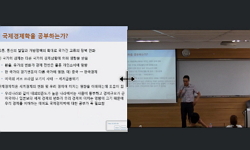This paper attempts to investigate trade potential for Korea-China and Korea-Japan using modified gravity models. To avoid biased results stemming from simple OLS estimation, especially heteroskedasticity problem, various estimation techniques were us...
http://chineseinput.net/에서 pinyin(병음)방식으로 중국어를 변환할 수 있습니다.
변환된 중국어를 복사하여 사용하시면 됩니다.
- 中文 을 입력하시려면 zhongwen을 입력하시고 space를누르시면됩니다.
- 北京 을 입력하시려면 beijing을 입력하시고 space를 누르시면 됩니다.
https://www.riss.kr/link?id=A82634171
- 저자
- 발행기관
- 학술지명
- 권호사항
-
발행연도
2010
-
작성언어
Korean
- 주제어
-
KDC
307
-
등재정보
KCI등재
-
자료형태
학술저널
-
수록면
117-133(17쪽)
-
KCI 피인용횟수
0
- 제공처
-
0
상세조회 -
0
다운로드
부가정보
다국어 초록 (Multilingual Abstract)
This paper attempts to investigate trade potential for Korea-China and Korea-Japan using modified gravity models. To avoid biased results stemming from simple OLS estimation, especially heteroskedasticity problem, various estimation techniques were used, i.e., fixed effect, random effect, between effect, Hausman-Taylor, Hausman-Taylor AR(1) and Random Effects GLS with Common AR(1). Considering the magnitude of our regression coefficients, the latter seems to be the most relevant estimation method to our model. Consequently, we used Random Effects GLS with Common AR(1) to measure more precisely Korea-China, and Korea-Japan trade potentials. The estimated coefficients from the Random Effects GLS with Common AR(1) were then employed to predict those bilateral trade potentials in between 2001 and 2006. The results show that Korea and China had traded more than the predicted potential trade levels from 2001 to 2006. The amount above the predicted trade potential between Korea and China increased every year from 8.6 bn. dollars in 2001 to 34bn. in 2006. On the other hand, Korea and Japan had traded less than the predicted potential trade level during the same period implying that Korea-Japan trade potential has not been exhausted yet. For example, in 2006, the amount of unexhausted trade potential between the two reached 24bn. dollars suggesting some policy implications to enhance Korea-Japan economic relationship.
참고문헌 (Reference)
1 Ozdeser H., "Turkey’s Trade Potential with Europ Zone Countries: A Gravity Studies" 43 (43): 15-23, 2010
2 Santos Silva J.M.C., "The log of gravity" 88 : 641-658, 2006
3 Bergstrand, J., "The gravity equation in international trade: some microeconomic foundation and empirical evidence" 67 : 474-481, 1985
4 Ruiz J., "The Wise Use of Dummies in GravityModels: Export Potentials in the European Region" Bank of Spain 2007
5 Subramanian A., "The WTO promotes trade, strongly but unevenly" 72 : 151-175, 2006
6 Rose A. K., "The Olympic Effect" 2009
7 Matyas L., "The Gravity Model: Some Econometric Considerations" 21 (21): 397-401, 1998
8 Kalbasi H., "The Gravity Model and Global Trade Flows. unpublished manuscript"
9 Frankel, J. A., "Regional Trading Blocs" Institute for International Economics 1997
10 Anderson, J. E., "Gravity with gravitas: a solution to the border puzzle" 93 (93): 170-192, 2003
1 Ozdeser H., "Turkey’s Trade Potential with Europ Zone Countries: A Gravity Studies" 43 (43): 15-23, 2010
2 Santos Silva J.M.C., "The log of gravity" 88 : 641-658, 2006
3 Bergstrand, J., "The gravity equation in international trade: some microeconomic foundation and empirical evidence" 67 : 474-481, 1985
4 Ruiz J., "The Wise Use of Dummies in GravityModels: Export Potentials in the European Region" Bank of Spain 2007
5 Subramanian A., "The WTO promotes trade, strongly but unevenly" 72 : 151-175, 2006
6 Rose A. K., "The Olympic Effect" 2009
7 Matyas L., "The Gravity Model: Some Econometric Considerations" 21 (21): 397-401, 1998
8 Kalbasi H., "The Gravity Model and Global Trade Flows. unpublished manuscript"
9 Frankel, J. A., "Regional Trading Blocs" Institute for International Economics 1997
10 Anderson, J. E., "Gravity with gravitas: a solution to the border puzzle" 93 (93): 170-192, 2003
11 Baldwin, R., "Gravity for dummies and dummies for gravity equations" 2006
12 Wooldridge, Jeffrey M., "Econometric Analysis of Cross-Section and Panel Data" MIT Press 2002
13 Cheng I. H., "Controlling for Heterogeneity in Gravity Models of Trade and Integration" 87 (87): 49-63, 2005
14 Rahman M. M., "Australia’s Global Trade Potential: Evidence from the Gravity Model Analysis" 2009
15 Egger P., "An Econometric View on the Estimation of Gravity Models andthe Calculation of Trade Potentials" 25 (25): 297-392, 2002
16 Egger P., "Alternative Techniques for Estimation of Cross-Section GravirtyModels" 13 (13): 881-891, 2005
17 Panazoglou C., "A Gravity Model Forecast of the Potential Trade Effects of EU Enlargement: Lessens from 2004 and Path-dependency in Integration" 29 (29): 1077-1089, 2006
동일학술지(권/호) 다른 논문
-
중국의 도시주택가격 결정요인과 부동산금융 부실화 가능성 분석
- 한중사회과학학회
- 오대원 ( Dae Won Oh )
- 2010
- KCI등재
-
수출보험의 수출촉진효과에 대한 이론과 현상에 관한 연구 -중국의 전자 및 기계류 등 하이테크산업을 중심으로-
- 한중사회과학학회
- 송재두 ( Jae Do Song )
- 2010
- KCI등재
-
- 한중사회과학학회
- 손상범
- 2010
- KCI등재
-
중국 조선산업 성장에 관한 고찰 -한,중 비교를 중심으로-
- 한중사회과학학회
- 김태식 ( Tae Shik Kim )
- 2010
- KCI등재
분석정보
인용정보 인용지수 설명보기
학술지 이력
| 연월일 | 이력구분 | 이력상세 | 등재구분 |
|---|---|---|---|
| 2026 | 평가예정 | 재인증평가 신청대상 (재인증) | |
| 2020-01-01 | 평가 | 등재학술지 유지 (재인증) |  |
| 2017-01-01 | 평가 | 등재학술지 유지 (계속평가) |  |
| 2013-01-01 | 평가 | 등재학술지 유지 (등재유지) |  |
| 2010-01-01 | 평가 | 등재학술지 선정 (등재후보2차) |  |
| 2009-01-01 | 평가 | 등재후보 1차 PASS (등재후보1차) |  |
| 2007-01-01 | 평가 | 등재후보학술지 선정 (신규평가) |  |
학술지 인용정보
| 기준연도 | WOS-KCI 통합IF(2년) | KCIF(2년) | KCIF(3년) |
|---|---|---|---|
| 2016 | 0.39 | 0.39 | 0.41 |
| KCIF(4년) | KCIF(5년) | 중심성지수(3년) | 즉시성지수 |
| 0.35 | 0.34 | 0.553 | 0.31 |




 KISS
KISS




